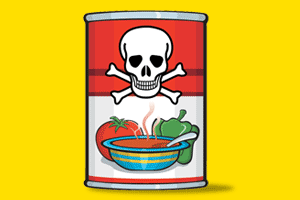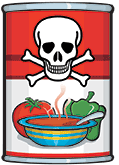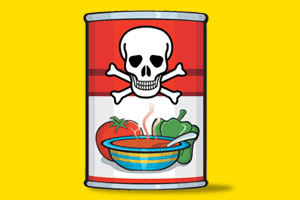
Illustration: Rob Dobi (Econundrums); Stephen St-Maurice/istockphoto.com (Can illustration)
I’m too lazy a cook not to love cans. Quick, cheap, and recyclable, they’ve gotten me through many a long, tomatoless winter. Besides, I inherited a kind of a feminist reverence for them—didn’t packaged foods help women cast off their domestic chains and all that? But recent research suggests that modern feminists, especially those inclined toward motherhood, might want to think twice before stocking up on Progresso soup.
Peek inside any can and you’ll notice a thin film separating your food from the metal. During the 1950s, manufacturers began lining cans with plastic to fend off bacteria that could get into food and drinks if the container corroded. The biggest concern was food-borne botulism, an illness that used to kill six in ten of its victims. Thanks to liners and rigorous sterilization, botulism in commercial canned goods is now pretty rare. Trouble is, most can liners contain bisphenol A (BPA), a chemical that can leach into the food. Last year, the nonprofit Consumers Union found it in 18 of 19 canned foods it tested: Progresso Vegetable Soup topped the list with 22 micrograms of BPA per serving—116 times Consumers Union’s recommended daily limit, which is based on animal studies.
Not good, considering the list of modern plagues researchers have tentatively linked to the chemical: obesity, diabetes, heart disease, breast and prostate cancer, and reproductive problems, among others. Many scientists suspect that BPA interferes with hormonal function—especially in fetuses and children: A 2005 study published in the journal Human Reproduction found that women who had miscarried three or more times showed significantly higher levels of the chemical than women who’d had successful pregnancies.
In an ongoing study at the Cincinnati Children’s Hospital Medical Center, part of which was published last December, mothers with higher levels of BPA in their urine early in pregnancy tended to have daughters who behaved more aggressively than daughters of moms with low BPA levels. Hugh Taylor, an expert in reproductive endocrinology at Yale School of Medicine, thinks some of BPA’s effects might not show up for a generation: His team injected pregnant mice with the chemical and found that it altered the babies’ uterine genes, leaving them less fertile than their mothers.
You’d think such findings would send the food industry scrambling for alternatives—indeed, some manufacturers have gone BPA-free with children’s products like pacifiers, infant bottles, and sippy cups. But canners have held their ground. John Rost, chairman of the North American Metal Packaging Alliance, told me BPA is still the gold standard. “It’s not for us to determine whether these materials are safe or not,” he said. “That’s up to the regulators.”
The regulators, meanwhile, can’t seem to make up their minds. In August 2008, the Food and Drug Administration affirmed (PDF) its long-held view that BPA is safe. A month later, the National Toxicology Program of the National Institutes of Health declared it to be of “some concern for effects on the brain, behavior, and prostate gland in fetuses, infants, and children at current human exposures.” The FDA then reassessed, saying it agreed with the NIH—but it has yet to restrict the chemical, even in infant formula cans. This June, the Natural Resources Defense Council, which two years ago asked the agency to ban BPA in food packaging, sued the FDA for failing “to safeguard the food supply.”
A handful of countries and US states, most recently New York, have moved to restrict the use of BPA in food and drink containers for young children, and a trio of federal legislators has proposed removing it from all food packaging. But manufacturers are pushing back. Food, can, and chemical interests have spent millions of dollars trying to thwart a California ban. Last year, after meeting with industry lobbyists, Environmental Protection Agency officials excluded BPA from a list of chemicals due for stricter regulation, saying they would delay action on it for at least two years. According to the Milwaukee Journal Sentinel, the lobbyists presented industry-funded studies showing that BPA was safe. (The EPA has since said it “intends to consider” taking action.)
All this equivocating is particularly maddening given that safe alternatives already exist. In 1999, Eden Foods, which sells organic goods, began lining most of its cans with a plant-based oleoresin. CEO Michael Potter calls the switch a “no-brainer,” even though the new cans cost 14 percent more. “I eat this stuff,” he says. “And so do my kids.” Canning trade rep Rost dismisses oleoresins as impractical due to shelf-life concerns, but Potter says Eden hasn’t had a single case of contamination. For high-acid foods like tomatoes, which can eat away at oleoresins, companies have turned to those paper-and-aluminum cartons already used to package certain soups. But Potter says he’s not surprised that major food companies and canners are resisting the new options. “They have hundreds of millions of dollars invested in BPA,” he says. “They do not want to change anything.”
If you don’t want to wait around for BPA-free cans to go mainstream, you might consider taking matters into your own hands. A home canning kit with mason jars costs about $60, and BPA-free lids are available online. Despite the snark of naysayers (a recent Slate article concluded that home canning was a “ridiculously trendy” pain in the butt that saved neither time nor money), the DIY method isn’t difficult—and you can minimize the botulism risk by closely following sterilization instructions available on websites such as FoodinJars.com. I gave canning a shot this spring, and it went surprisingly well: My pickled veggies were pleasantly briny and more mouth-puckeringly sour than store-bought. And without the side effects.
POISON PANTRY?
|
CONSUMERS UNION recommends ingesting no more than .0011 micrograms of BPA daily per pound of body weight. But it found at least 20 times the limit for a typical adult in a single serving of several canned foods it tested. The top five offenders: |
BPA PER SERVING (AVERAGE IN MICROGRAMS) |
EXCEEDS DAILY LIMIT BY A FACTOR OF |
|
 |
Progresso Vegetable Soup |
22.0 |
115 |
|
Del Monte Fresh Cut Green Beans |
14.9 |
77 |
|
|
Campbell’s Condensed Chicken Noodle Soup |
10.2 |
53 |
|
|
Annie’s Homegrown Organic Cheesy Ravioli |
7.7 |
39 |
|
|
Hormel Chili With Beans |
6.1 |
31 |
|















